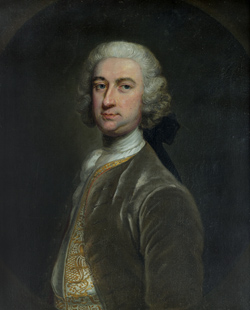In November 1768, New York newspapers went back and forth over the accuracy of their reports on an effigy-burning in that city.
Remarkably, the effigies were of two royal officials in Massachusetts: Gov. Francis Bernard and Sheriff Stephen Greenleaf. Since the people of Massachusetts had the most reason to care, how did the Boston press react to that event?
The first Boston newspaper to run the story was Richard Draper’s Boston News-Letter, which reprinted the New-York Journal’s initial article on 24 November. After that story came another news item from New York:
It is also said that among the Toasts drank at a Meeting of Ninety-two reputable Tradesmen at New-York, was the following, Confusion in General G[reenlea]fe, & Success to [John] Brown, the Brave Weaver of Boston.
Those toasts and the effigies showed that the Boston Whigs’ reports on the
Manufactory siege had had the intended effect of riling up sympathetic Whigs in other parts of America. Draper leaned toward the Crown, so the
News-Letter immediately took aim at the Whigs “Journal of Occurrences”:
Our Readers may be ignorant of the Occasion of the foregoing Proceedings at New-York, we would inform them that a Journal of the Proceedings in the Town of Boston since the first Arrival of Troops, with Remarks on many Paragraphs, are sent weekly there, and published in the New-York Gazette, which Journal has not been printed here, & only a Part in the Paper of any other Government.—The Articles in said Journal may properly be called INTELLIGENCE VERY EXTRAORDINARY—many of them being of an extraordinary Nature—some extraordinary New to People in this Town—some very true—and some very false.
Copies of the two newspapers called the
New-York Gazette must have reached Boston shortly after that, casting doubt on the initial
New-York Journal report. I haven’t found any mention of the effigy-burning in
Edes and Gill’s
Boston Gazette, the newspaper closest to the Whigs, so I’m guessing they decided the story was too hot to touch.
Instead, the 28 November
Boston Gazette published a response to the
News-Letter’s insinuations about the Whigs’ dispatches:
Messrs. Edes & Gill,
If Mr. Draper, or the elegant Editor of the Paragraph in his last Paper, respecting the JOURNAL published in New-York, can point out a single Instance of a false or unfair Representation of the Conduct of his Majesty’s Troops, or of any Person or Matter therein, taken Notice of, it is desired it may be done in the next Thursday’s Paper, otherwise Mr. Draper must be content to be looked upon as having attempted to deceive the Public, who have a Right to an immediate Recantation.
N.
Eventually the Whigs’ “Journal of Occurrences” spread word of the New York effigy-burning, but only out of town. That news item didn’t circle back to Boston for months.
The 28 November
Boston Gazette also included a more florid description of the tradesmen’s gathering in New York, credited to a Philadelphia newspaper on 14 November (which I can’t access):
A Correspondent writes us from New-York, that at a late Meeting of Ninety-two respectable Tradesmen there, (who dined together on Beef-Stakes, and drank nothing but American Porter) they came to the Resolution of purchasing no British Manufactures of any Sort or Kind, ’till there is a Dissolution of the cowardly and treacherous Governor B——d’s Military-Civil Government in Boston, and Change of Measures relative to this Country in general—that they are determined never to rescind from their Resolution—and are persuaded there are not seventeen TRADESMEN in the whole Province, so lost to all Sense of Virtue and Love for their Country, as to dissent from them in Opinion.—And that among a Number of spirited and humorous Toasts, characteristic of British Independence, they gave—Confusion to General G—nl—fe, and Success to Brown, the brave Weaver of Boston.
The emphasis on the ninety-two diners, the no more than seventeen who might dissent, and the word “rescind” all alluded to the
previous big bone of contention in Massachusetts politics, the
Circular Letter. The early summer of 1768 must have seemed so far away by then.
Green and Russell’s
Boston Post-Boy had the last word on the effigies, in their 5 December issue:
His Excellency Sir HENRY MOORE, Governor of New-York, has, with the unanimous Advice of His Majesty’s Council, issued a Proclamation offering a Reward of £50 to any Person who shall discover any of the Rioters, who on the Evening of the 14th ult. [i.e., of last month] carried about certain Figures or Effigies, & burnt the same near the Merchants Coffee-House in that City.
The official record of that reward,
quoted yesterday, didn’t actually mention effigies or the Merchants’ Coffee-House, just a general riot. But even with imperfect, politically shaped journalism, everyone knew what the governor was talking about.
















